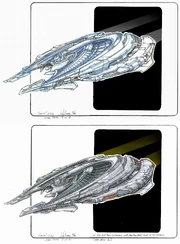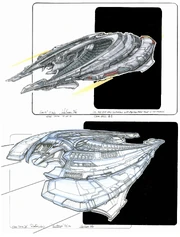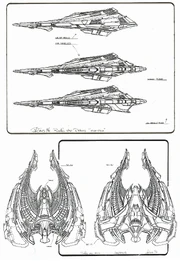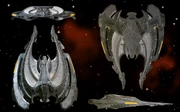(→Design) |
m (→Design) |
||
| Line 5: | Line 5: | ||
==Design== |
==Design== |
||
| − | John Eaves based the look of Ru'afo's flagship on two main points of visual inspiration. He stated, "''I tried to combine the horseshoe shape with the inside of a piano. You see all the wires, which I thought was kind of cool.''" (''[[The Secrets of Star Trek: Insurrection]]'', p. 88) Though Eaves intended for the {{w|grand piano}} motif to be reflected throughout each of the Son'a vessels, he meant for Ru'afo's flagship to be a particularly strong example of this idea. "''You see a lot of repetitive strings, a lot of repetitive kind of wiring going through the main architecture. And the thing with Ru'afo's ship, you'll see that through the interior of the ship.''" ("The Art of Insurrection", {{DVD|Star Trek: Insurrection|Special Edition| |
+ | John Eaves based the look of Ru'afo's flagship on two main points of visual inspiration. He stated, "''I tried to combine the horseshoe shape with the inside of a piano. You see all the wires, which I thought was kind of cool.''" (''[[The Secrets of Star Trek: Insurrection]]'', p. 88) Though Eaves intended for the {{w|grand piano}} motif to be reflected throughout each of the Son'a vessels, he meant for Ru'afo's flagship to be a particularly strong example of this idea. "''You see a lot of repetitive strings, a lot of repetitive kind of wiring going through the main architecture. And the thing with Ru'afo's ship, you'll see that through the interior of the ship.''" ("The Art of Insurrection", {{DVD|Star Trek: Insurrection|Special Edition|(Special Edition)}} [[DVD]]) |
| − | [[File:Ru'afo's flagship original orientation design by John Eaves.jpg|thumb|Eaves' original orientation design intent for Ru'afo's ship |
+ | [[File:Ru'afo's flagship original orientation design by John Eaves.jpg|thumb|Eaves' original orientation design intent for Ru'afo's ship, from February 1998]] |
| − | As the first Son'a ship to make an appearance in the movie, Ru'afo's ship was the first one Eaves addressed. It was made smaller than the {{USS|Enterprise|NCC-1701-E|-E}} and Eaves later remarked that it was "maybe about the same size as the dish of the ''Enterprise''." ("The Art of Insurrection", {{DVD|Star Trek: Insurrection|Special Edition| |
+ | As the first Son'a ship to make an appearance in the movie, Ru'afo's ship was the first one Eaves addressed. It was made smaller than the {{USS|Enterprise|NCC-1701-E|-E}} and Eaves later remarked that it was "maybe about the same size as the dish of the ''Enterprise''." ("The Art of Insurrection", {{DVD|Star Trek: Insurrection|Special Edition|(Special Edition)}} [[DVD]]) |
In February 1998, Eaves finished up his design work on Ru'afo's ship. "''I drew it to fly with the forks forward, because it looked more aggressive,''" he recalled. (''[[The Secrets of Star Trek: Insurrection]]'', p. 87) However, upon turning it over for appraisal, Eaves soon found out that his designs had been misinterpreted. "''We had a lot of trouble with Ru'afo's ship [....] When I turned it over to the meeting, they had the impression that it was flying the other way. I guess I made the assumption that I always draw things flying forward and I forgot to indicate that on the drawing.''" ({{STTM|1|3}}, p. 21) |
In February 1998, Eaves finished up his design work on Ru'afo's ship. "''I drew it to fly with the forks forward, because it looked more aggressive,''" he recalled. (''[[The Secrets of Star Trek: Insurrection]]'', p. 87) However, upon turning it over for appraisal, Eaves soon found out that his designs had been misinterpreted. "''We had a lot of trouble with Ru'afo's ship [....] When I turned it over to the meeting, they had the impression that it was flying the other way. I guess I made the assumption that I always draw things flying forward and I forgot to indicate that on the drawing.''" ({{STTM|1|3}}, p. 21) |
||
Revision as of 11:29, 2 March 2013
Template:Realworld

Ru'afo's flagship
The script of Star Trek: Insurrection did not give any description of Ru'afo's flagship, leaving Illustrator John Eaves to his own devices to come up with a design for the ship, a design ethic that suited him just fine. (Star Trek: The Magazine Volume 1, Issue 3, p. 20)
Design
John Eaves based the look of Ru'afo's flagship on two main points of visual inspiration. He stated, "I tried to combine the horseshoe shape with the inside of a piano. You see all the wires, which I thought was kind of cool." (The Secrets of Star Trek: Insurrection, p. 88) Though Eaves intended for the grand piano motif to be reflected throughout each of the Son'a vessels, he meant for Ru'afo's flagship to be a particularly strong example of this idea. "You see a lot of repetitive strings, a lot of repetitive kind of wiring going through the main architecture. And the thing with Ru'afo's ship, you'll see that through the interior of the ship." ("The Art of Insurrection", Star Trek: Insurrection (Special Edition) DVD)

Eaves' original orientation design intent for Ru'afo's ship, from February 1998
As the first Son'a ship to make an appearance in the movie, Ru'afo's ship was the first one Eaves addressed. It was made smaller than the USS Enterprise-E and Eaves later remarked that it was "maybe about the same size as the dish of the Enterprise." ("The Art of Insurrection", Star Trek: Insurrection (Special Edition) DVD)
In February 1998, Eaves finished up his design work on Ru'afo's ship. "I drew it to fly with the forks forward, because it looked more aggressive," he recalled. (The Secrets of Star Trek: Insurrection, p. 87) However, upon turning it over for appraisal, Eaves soon found out that his designs had been misinterpreted. "We had a lot of trouble with Ru'afo's ship [....] When I turned it over to the meeting, they had the impression that it was flying the other way. I guess I made the assumption that I always draw things flying forward and I forgot to indicate that on the drawing." (Star Trek: The Magazine Volume 1, Issue 3, p. 21)

Eaves' reversed-orientation design for Ru'afo's ship, finalized in April 1998
As it turned out, it was Co-Producer Peter Lauritson who had different ideas. "There was also a funny thing, because Peter Lauritson was our effects supervisor, and when I sent the drawings over, he liked what he saw, he started getting it all approved. And then when we started to do the plan view, he goes, 'Okay, put the engines on this side, make them glow over here,' and I go, 'Oh, that's the front of the ship.' And so we had this huge kind of a discussion on which way the ship was going to fly at that point. And I had drawn everything with that kind of forward fork motion, kind of carried the architecture through it, and Peter liked the opposite view. And so I remember we went all over that drawing to make it go the right direction, carry the right way, and that was kind of funny." ("The Art of Insurrection", Star Trek: Insurrection (Special Edition) DVD)
Multiple meetings concerning the design of the Son'a flagship were held. Eaves remembered, "They did all their meetings and plans with it flying the other way, so when I got into the detailed identification of the parts, they said, 'What's the bridge doing in the back?' They understood my point of view, but it was a pretty heavy discussion on which way it was going to fly, and I fought for it pointing the more aggressive way. If you don't know you couldn't tell, but I still feel that it's going backwards!" (Star Trek: The Magazine Volume 1, Issue 3, p. 21) The discussions to and fro took almost two months, and it was not until April that Eaves presented his final redrawn design sketches with the adjusted flight direction. Years later, Eaves conceded, "Overall it didn’t really make a big difference. That is being that that was over 10 years ago, so my sadness has faded." [1]
CGI model

Eaves' elevation plans for SBS
The movie Insurrection was the first feature film where it was conceived that all the visual effects would be executed as computer-generated imagery (CGI). At that point in time, the technique was still relatively new, and the workload entailed in creating these effects was such that it was decided to employ two effects houses for their creation; Blue Sky/VIFX was contracted to provide all planet-bound effects, as well as the interior Son'a collector visuals (and, as it turned out during production, its destruction as well), whereas Santa Barbara Studios (SBS) would be responsible for all the space-bound visuals. The construction of Ru'afo's ship therefore fell to SBS. SBS' Effects Supervisor John Grower stated, "John [Eaves] sent us elevation views and one or two 3/4 perspective drawings of each ship, but we had to do a lot of deduction work. The Son'a Flagship and Battleships had very complex shapes and all of these incredible compound curves, which didn't appear in the plan views. They're thin in one dimension and very wide and long in the other, kind of like a trilobite. The biggest challenge was that the Son'a ships didn't look the same from one angle to the next, so if we rotated around them a little bit, their profile changed because they had hundreds of compound curves that hooked together to form their shape. Getting it all to flow involved a ton of work and a very long modeling process." Apart from the intricate designs, creating digital ships on the computer was a labor, and time consuming effort from a technological standpoint as well, given the state of CGI technology at the time, as Grower further recalled, "Each ship was made up of lots of nurb surfaces, and the databases were hundreds of megabytes per ship. These models were very heavy, but Maya [remark: the CGI software package of choice at SBS] allowed us to efficiently structure and organize the data. We went through several iterations [of the ship designs] before we got approval, and Maya helped a lot there as well. Once we got the ships approved, of course, we had to make them look real."

SBS' finalized CGI model of Ru'afo's ship
As for texturing the CGI models, instead of applying texture maps, and skin, around their wireframe models, as was the later commonplace method, SBS used a method called "slide projectors", recalled by Grower as , "Imagine a spaceship with all of these slide projectors pointed at various parts of it, projecting high-resolution images which dissolve from one projector to the next where they overlap so we don't see any seams. That allows us to have infinite detail as we rotate around the ship, without all of the stretching problems that occur when we wrap a flat object around 3-D geometry. It was imperative for us to use this approach because of the multi-curved surfaces of the ships. Also, instead of having a texture for every nurb surface, which is what we did before — and there might be hundreds — this technique enabled us to simultaneously project onto several nurb surfaces. Instead of having a hundred textures, we had 30 or so, over which we'd add dozens of layers of different textures and 'effects maps' per ship to create highlights and other things, and then we'd render them with Renderman. It was very time-consuming to get the CG models to look right, because the filmmakers have been shooting [the Trek] models for a long time, and they knew exactly what type of look they wanted. They would make us revise the models until they were right, which was very difficult." (American Cinematographer, January 1999, pp. 41-42)
Still Animation Supervisor James Strauss considered the effort worthwhile, "There is a kind of look and feel in the way ships move and conduct themselves in these pictures, and it is usually like a naval battle, with broadsides being fired off. In this movie there was an attempt to do more wild actions–probably since we were using CG and didn't have to worry about the lack of flexibility with [physical] model mounts." (Cinefex, isuue 77, p. 79)
Though later mentioned in the Star Trek: Deep Space Nine television series, the Son'a would never again be featured, nor would any of their ships, so the CGI models were not upgraded in the LightWave 3D CGI software.
